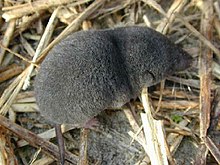Blarina
Genus of mammals
This article is about the shrew. For the fictional species from Star Wars, see List of Star Wars species (A–E) § Blarina.
| American short-tailed shrews[1] Temporal range: Late Pliocene to Recent | |
|---|---|
 | |
| Southern short-tailed shrew (Blarina carolinensis) | |
| Scientific classification | |
| Domain: | Eukaryota |
| Kingdom: | Animalia |
| Phylum: | Chordata |
| Class: | Mammalia |
| Order: | Eulipotyphla |
| Family: | Soricidae |
| Tribe: | Blarinini |
| Genus: | Blarina Gray, 1838 |
| Type species | |
| Corsira (Blarina) talpoides [1] | |
| Species | |
The genus Blarina, commonly called short-tailed shrews, is a genus of relatively large shrews with relatively short tails found in North America.
Description
[edit]They have 32 teeth and are in the red-toothed shrew subfamily. They generally have dark fur and thick feet. The saliva of these animals is toxic and is used to subdue prey.[2]
Species
[edit]Species are:[1]
- Northern short-tailed shrew B. brevicauda
- Southern short-tailed shrew B. carolinensis
- Elliot's short-tailed shrew B. hylophaga
- Everglades short-tailed shrew B. peninsulae
- Sherman's short-tailed shrew B. shermani; possibly extinct[3][4]
Ecoepidemiology
[edit]Short-tailed shrews are one of the animal reservoirs of the agents of Lyme disease and human babesiosis.[5]
References
[edit]- ^ a b c Wilson, D. E.; Reeder, D. M., eds. (2005). Mammal Species of the World: A Taxonomic and Geographic Reference (3rd ed.). Johns Hopkins University Press. pp. 269–270. ISBN 978-0-8018-8221-0. OCLC 62265494.
- ^ Kita M, Okumura Y, Ohdachi SD, Oba Y, Yoshikuni M, Nakamura Y, Kido H, Uemura D (February 2005). "Purification and characterisation of blarinasin, a new tissue kallikrein-like protease from the short-tailed shrew Blarina brevicauda: comparative studies with blarina toxin". Biological Chemistry. 386 (2): 177–82. doi:10.1515/BC.2005.022. hdl:2115/7398. PMID 15843162. S2CID 2884850.
- ^ "Blarina shermani". NatureServe Explorer. Retrieved 2023-03-30.
- ^ "Blarina shermani Hamilton, 1955". www.mammaldiversity.org. Retrieved 2023-03-30.
- ^ Telford III, S. R., Mather, T. N., Adler, G. H., & Spielman, A. (1990). Short-tailed shrews as reservoirs of the agents of Lyme disease and human babesiosis. The Journal of parasitology, 681-683 (abstract)
| Blarina | |
|---|---|
This article about a red-toothed shrew is a stub. You can help Wikipedia by expanding it. |
Retrieved from "https://en.wikipedia.org/w/index.php?title=Blarina&oldid=1189170320"


 French
French Deutsch
Deutsch